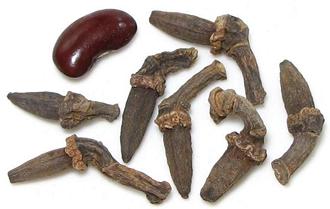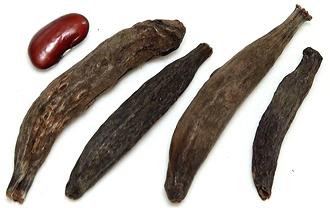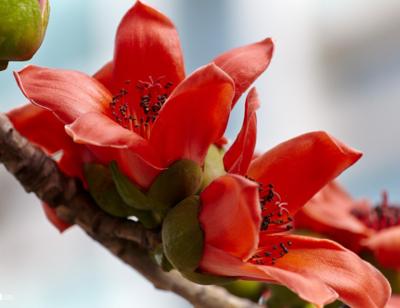

[Indian Capers (incorrect); Marathi Moggu (Kannada, Marathi); Shalmali, Semul (Hindi); Appakuttaka, Parappoola, Parapanni (Malayalam); Ilavu, Puulaa, Mullilavu, Badi Laung (Tamil); Andhra Moggu, Andhra Mogga; Ceiba pentandra of family Malvaceae (Mallow family)]
This tree is native to southern Mexico, the Caribbean, and northern South America, and variety guineensis is found in West Africa. It has been widely introduced into cultivation in South and Southeast Asia, mainly used for fiber from the mature pods, but also as a spice.
The flower buds of this tree are described as a "kind of caper" in many listings, but they obviously are nothing of the kind, they are flower buds of the Kapok Tree, a Mallow, not a Mustard. They are used to some extent in Maharashtra, but much more in Karnataka and Andhra Pradesh farther to the south. This spice is important in many rice dishes in those states. They are also an ingredient in masala powders in Chettinad, Tamil Nadu. Oil from the seeds can be used for cooking, but becomes rancid very quickly.
More on Mallows.
 [Lepan bwin, Let-pan (Burmese); Semal (Hindi); Shimul (Bengali); Ximolu
(Assamese); Bombax ceiba]
[Lepan bwin, Let-pan (Burmese); Semal (Hindi); Shimul (Bengali); Ximolu
(Assamese); Bombax ceiba]
This tree is native to India, Southeast Asia and southern China. The dried flowers of this tree are used in Burma (Myanmar) in soups. They are also gathered in Guangdong Province, China, dried, and used in soups and teas. In the Shan State of eastern Burma, and in adjacent northern Thailand, the dried cores of flower buds are used in soups and curries. It has been reported that the calyx (cup that surrounds the petals) of fresh flower buds is used as a vegetable in India.
In India, the dried buds are used as Marathi Moggu, just as from it's
relative Ceiba pentandra (see above).
Photo by Tlong Zhuhai distributed under license
Creative Commons
Attribution-ShareAlike v3.0 Unported.